Index


Review: New driver boosts performance even further
Gainward’s GTX 690 graphics card is based on Nvidia’s reference design, just like the rest of the aircooled GTX 690 cards that can be found. Nvidia openly stated that they don’t want the card’s air cooler replaced, although they did allow EVGA to strap it with water cooling. You can already find many different water blocks available, but also few air coolers such as Arctic Twin Turbo GTX 690, which launched a few days ago.
We’ve already tested the GTX 690, but the card performed slightly better today. However, it is not due to overclocking but rather due to the new drivers.
GTX 690 uses GK104 GPU, which is a part of Kepler family. Base GPU clock stands at 915MHz, which is 9% lower than the GTX 680’s Base Clock (1006MHz). In fact, this is the only difference when compared to GTX 680’s GPU. The rest of the specs reveal that the GK104 use on GTX 690 is identical to the one on GTX 680 cards. There’s no difference in memory either – the bandwidth is identical. The memory runs at 6008MHz (GDDR5) and each GPU has 2048MB of GDDR5 at its disposal.
Key Features:
-Kepler architecture
-NVIDIA GPU Boost
-NVIDIA Adaptive Vertical Sync
-NVIDIA TXAA and FXAA technology
-Microsoft DirectX 11 with DirectCompute5.0 support
-NVIDIA PhysXtechnology
-NVIDIA CUDA technology
-NVIDIA 3D Vision Ready
-NVIDIA Quad SLI Ready
-NVIDIA Surround
-PCI Express 3.0 support
-OpenGL 4.2 and OpenCLSupport
-Support for four concurrent displays including:
-DisplayPort1.2
-DVI 3 (dual-link)
The packaging that Gainward used for GTX 680/670 cards is already quite bulky, so there was no need to make a bigger one. The design is solid and will keep the card safe. Additionally, Nvidia’s decision to put the cards’ names on the sides made shopping for a new card much easier. 

The box holds a single 2x6-pin to 8-pin power cable, driver CD and Quick Start Installation Guide. The CD includes EXPERTool graphics card management utility and a good part of the Quick Start Manual is reserved for it. Naturally, we’ll discuss this in more detail in our OC section.
Gainward GTX 690 is a spitting image of the reference card. When it comes to this particular cooler, Nvidia has every reason to be proud and if there was a graphics card beauty pageant, it would definitely rank highly. However, the GTX 690’s cooling deserves praise for much more than its looks – it’s efficient and isn’t loud. No wonder Nvidia likes to show this card off so much.
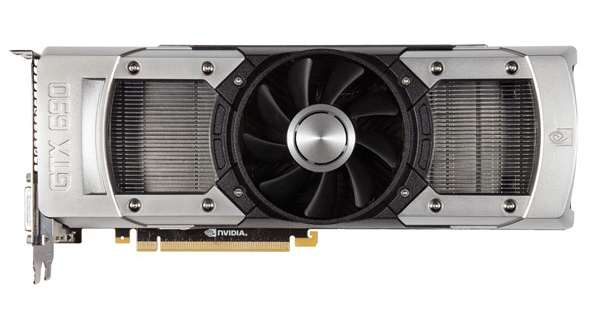
The cooler is two slots wide. On top of the cooler you’ll find “GEFORCE GTX” logo. The LED under the sign glows when the PC is ON.


The fan is enclosed in a magnesium bracket. Not only does this improve the looks, it ensures superior thermal and audio properties than most commonly used plastics and aluminum.
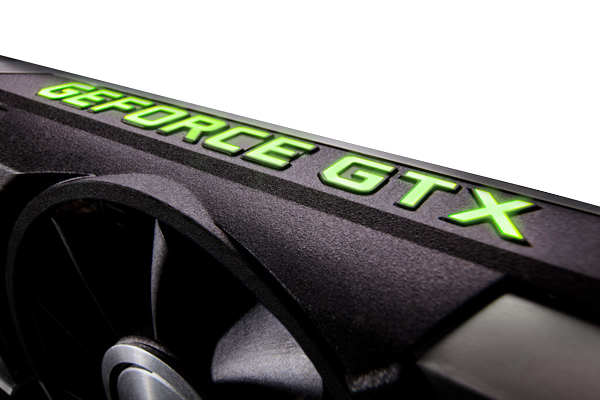
It’s obvious that the cooler received special treatment and every single inch of it breathes style. The side panels are made of polycarbonate and let users peek into the heatsink. The cooler actually has two separate heatsinks. The fan is placed in the middle, so as to cool both heatsinks at the same time.

Both heatsinks sit on nickel-plated vapor chambers. Vapor Chamber technology enables for making compact coolers, and GTX 690 is a perfect example of this.


Two GK104 graphics chips are linked via PCI-Express 3.0 SLI bridge chip (PLX design with 48 lanes). As for power supply, Nvidia used 10-phase power for the two GPUs and two phases for memory. The PCB is made of ten layers with 2OZ of copper per layer. All the components are low-profile, so that the cooler could sit on them comfortably and decrease turbulence and noise.
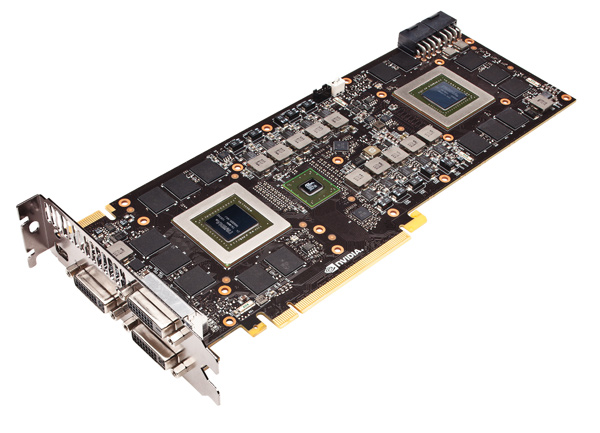
The card uses Samsung GDDR5 memory. The chips (model K4G20325FD-FC03) are specified to run at 1500 MHz (6000MHz GDDR5 effectively).
Complexity of the design is evident from the quite populated back of the PCB.
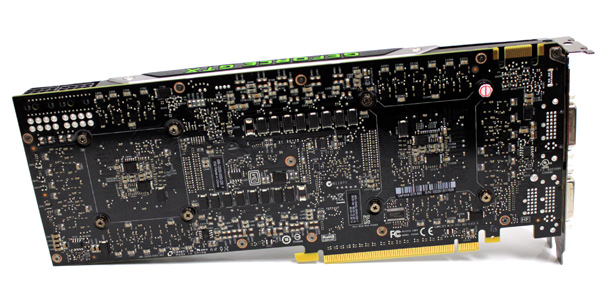
GTX 690 has four video connectors and all can be used simultaneously. The card has plenty of power to run 3D on three displays. The DVI connectors, all three of them, are dual-link capable. Two of them are DVI-I which means that they won’t support an analog VGA display. HDMI sound chip is in the GPU and that card comes with a DVI-to-HDMI dongle.
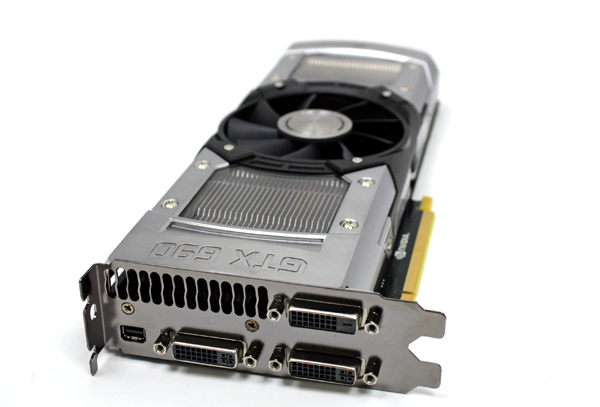
GTX 690 comes with a single SLI connector, meaning it can run in quad SLI.
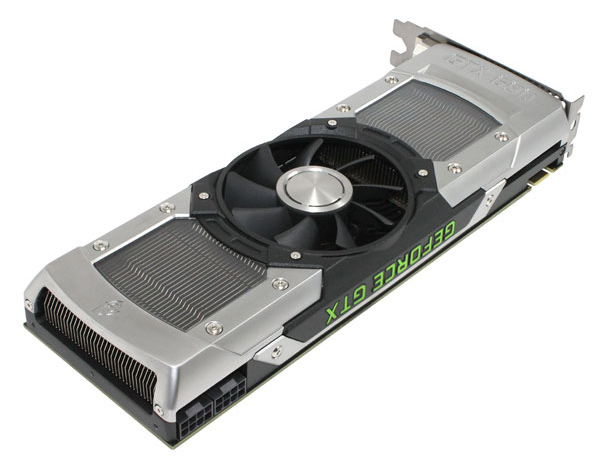
GTX 690 requires two 8-pin power connectors.

Motherboard: EVGA X79 FTW
CPU: Sandy Bridge-E Core i7 3820 (3.6GHz)
CPU Cooler: Thermalright HR-02 (Thermalright-Europa Distri www.PC-Cooling.de).
Memory: 8GB ADATA DDR3 1600 XPG Gaming series
Harddisk: OCZ Vertex 2 100 GB
Power Supply: CoolerMaster Silent Pro 1000W
Case: CoolerMaster Cosmos II Ultra Tower
Operating System: Win7 64-bit
Nvidia 306.23-desktop-win7-winvista-64bit
AMD 12-8_vista_win7_64_dd_ccc.exe
(AMD HD 7970 : 12-6_vista_win7_64_dd_ccc.exe)
(GTX 690 4GB & Gainward GTX 670 Phantom SLI : 301.34-desktop-win7-winvista-64bit-english-whql)
Crysis 2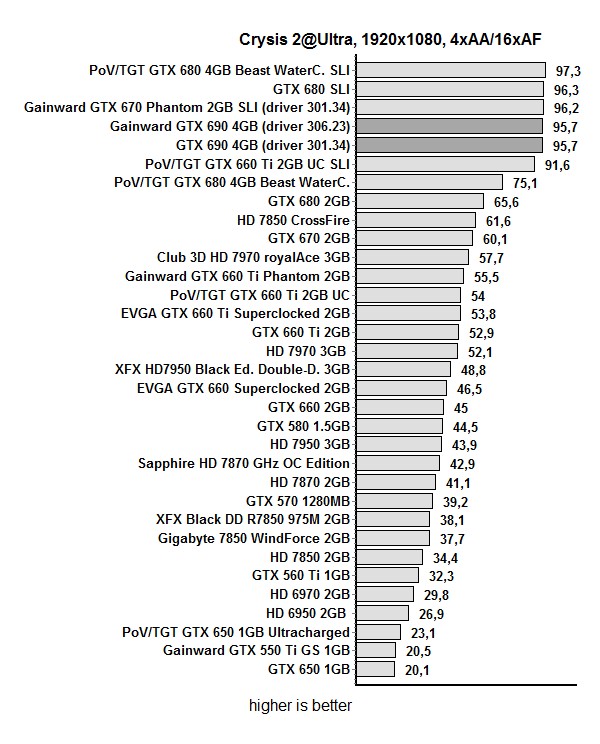
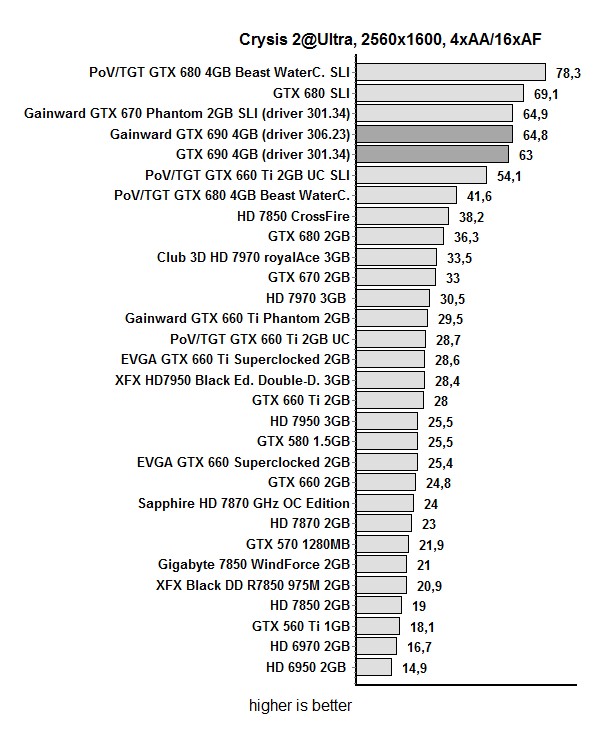
Metro 2033
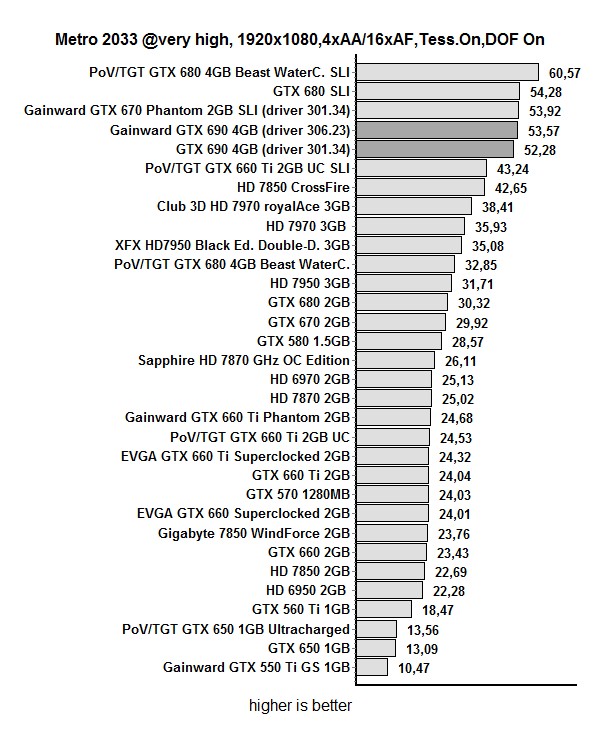
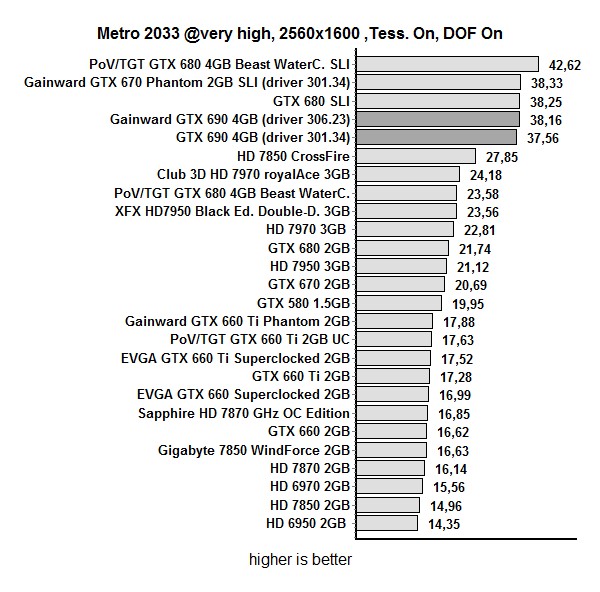
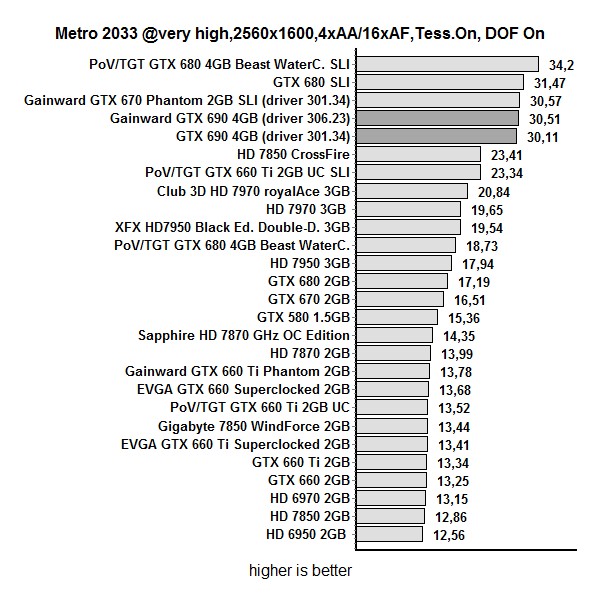
Aliens vs Predator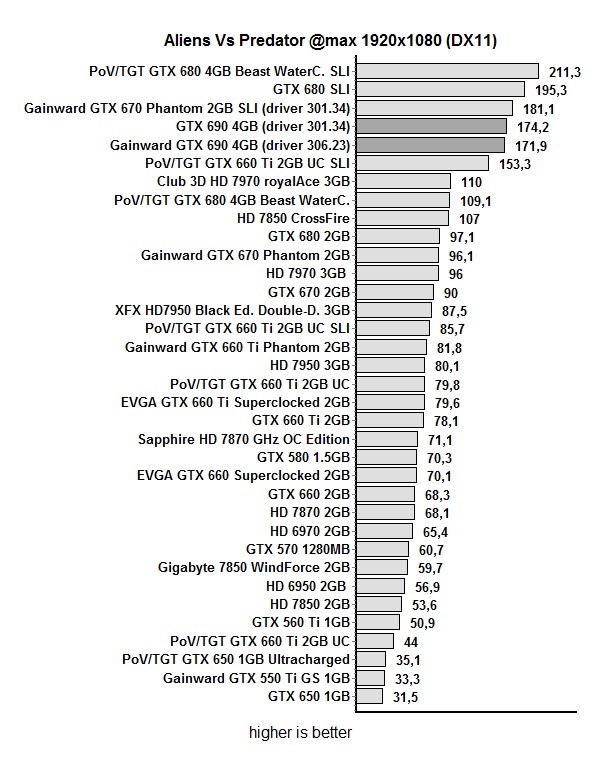
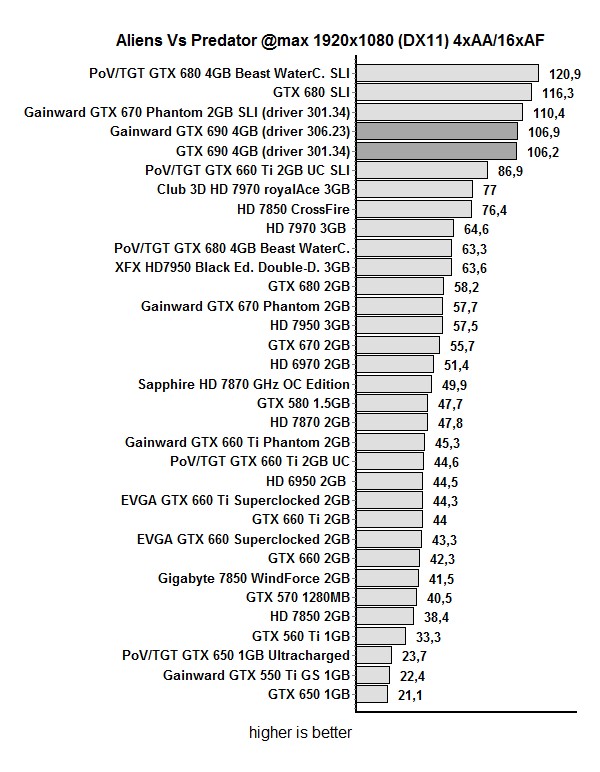
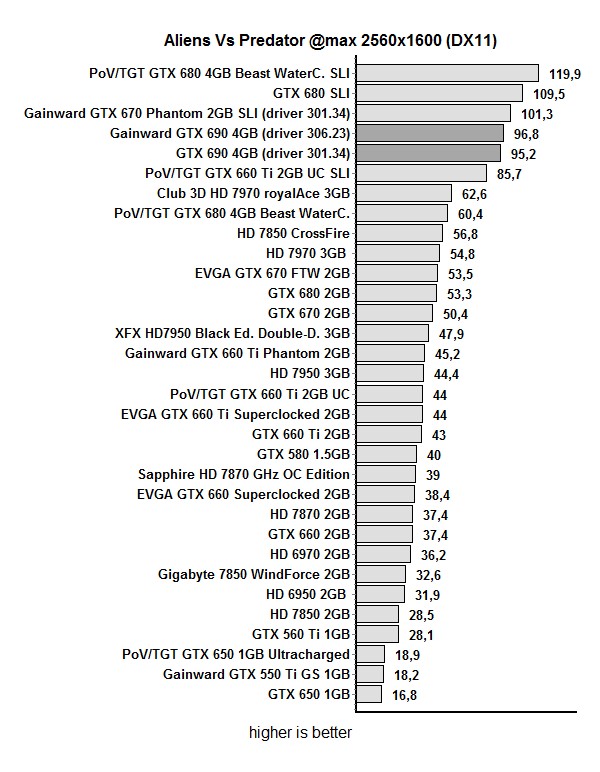
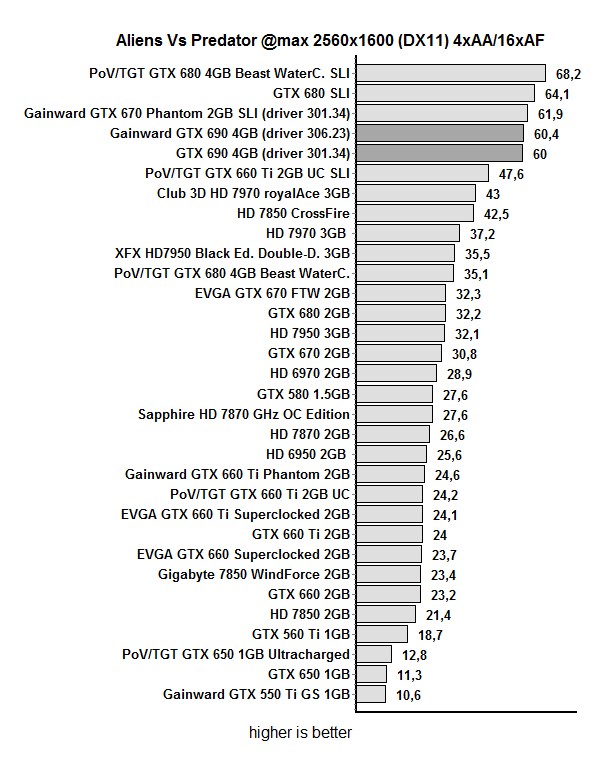
Unigine Heaven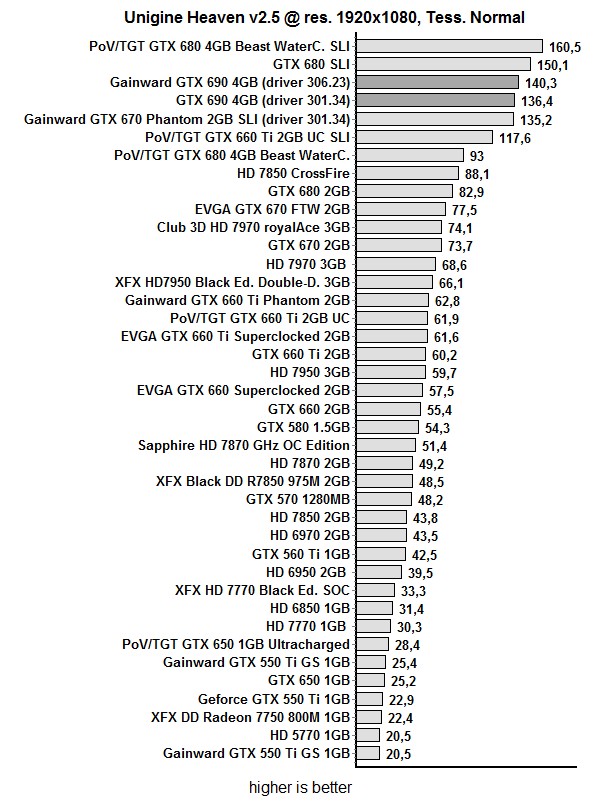
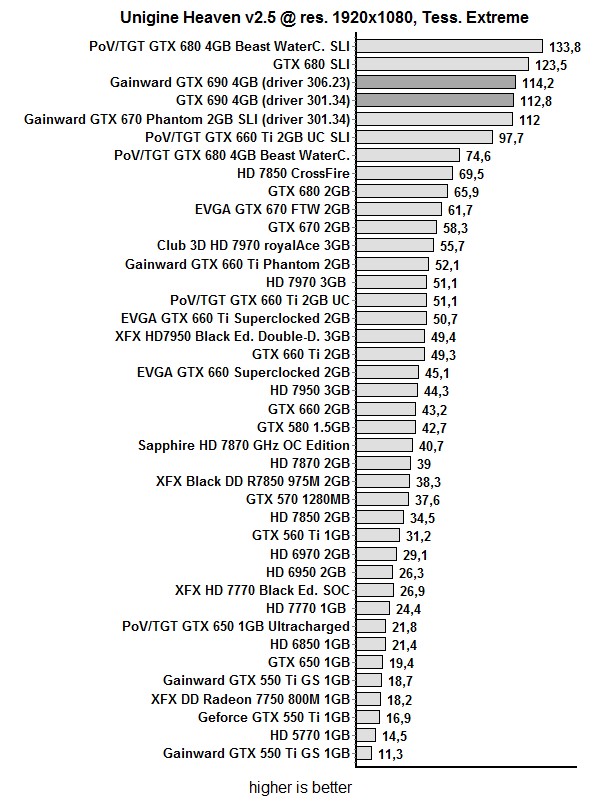
Gainward GTX 690 is a card based on reference design and although it won’t allow for more extreme overclocking, you can get some extra performance with little to no effort. Our reviewing sample allowed us to up the GPU Base clock from reference 915MHz to 1015MHz, which is an 11 percent overclock. The highest clock we hit after our overclocking was 1176MHz. The memory cooperated as well and we upped the clock by 250MHz (1000MHz GDDR5 effectively). Together this translated to up to 16 percent higher gaming performance.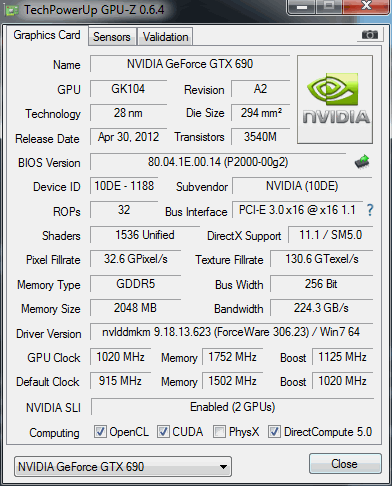
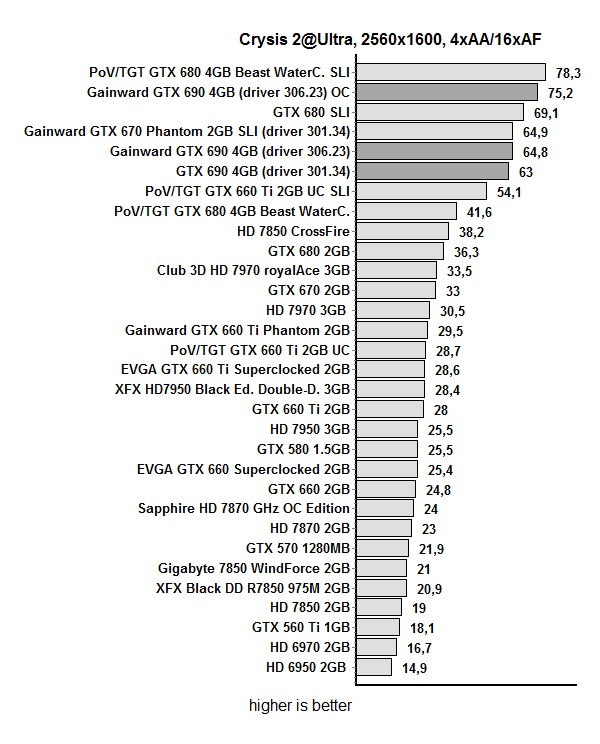
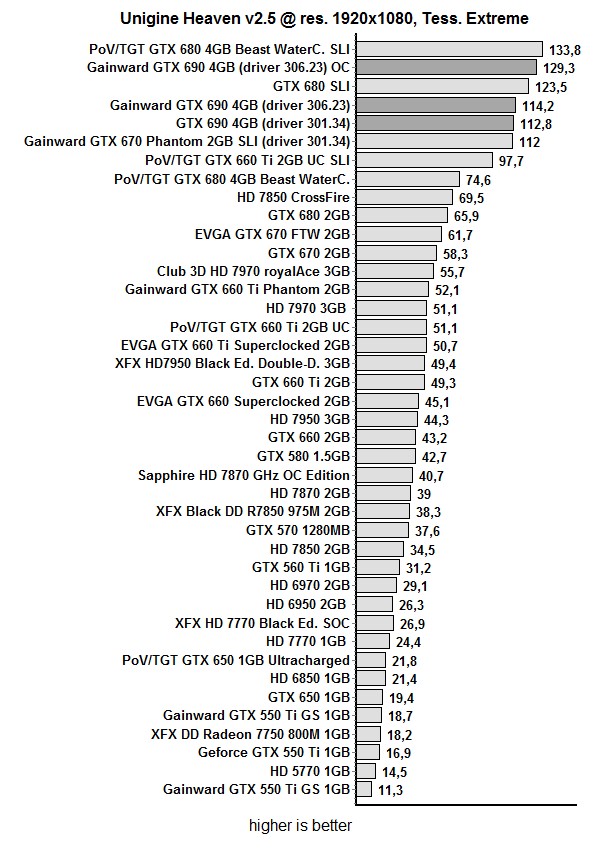
Of course, we took Ganiward’s EXPERTool out for a spin, as it now supports Kepler chips. Unfortunately, we could not get readings from both GPUs at the same time, but overclocking is easily doable from the panel with the same name.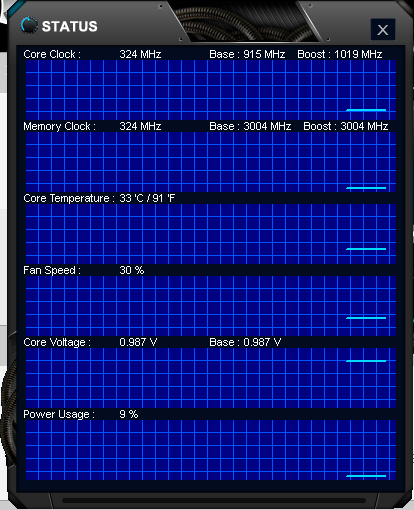
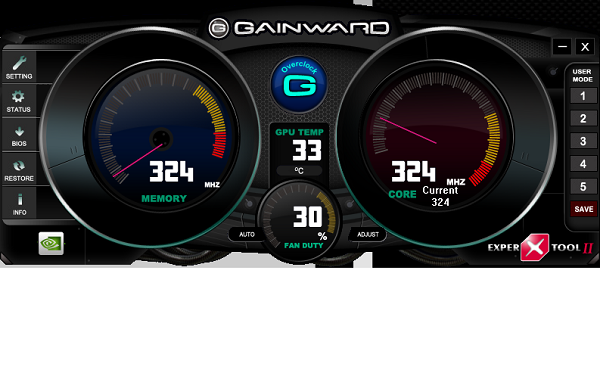
Nvidia is pleased with reference air cooling and so are we. In short, it’s better than any high end dual-GPU reference cooling solution we’ve tried. At the same time, the cooler doesn’t get too loud, not even when the card works full throttle, which is always a plus, especially for a card of this caliber.
The fans won’t get loud in AUTO mode, as their RPM does not exceed 2300. Only when you go beyond 2600RPM will you be able to hear it good from inside your rig. The card remains almost inaudible when idle. To put things in perspective – the GTX 690 is about as quiet as a single GTX 680, but definitely quieter than two GTX 680s in SLI.
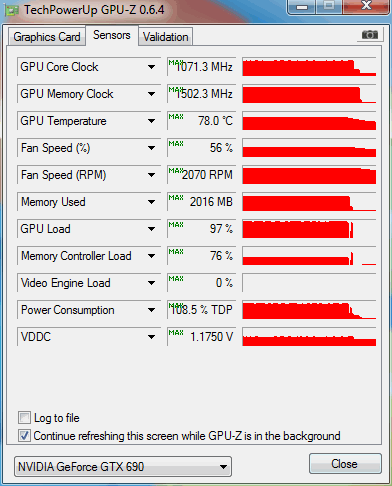
We didn’t have to speed up the fans manually for our overclocking, but we did it anyway to see how much will the temperature drop. Running at 1170MHz in AUTO fan mode, the GPU went up to 84°C. We noticed that the fans weren’t significantly faster than at reference clocks, which explained the higher GPU temperature.
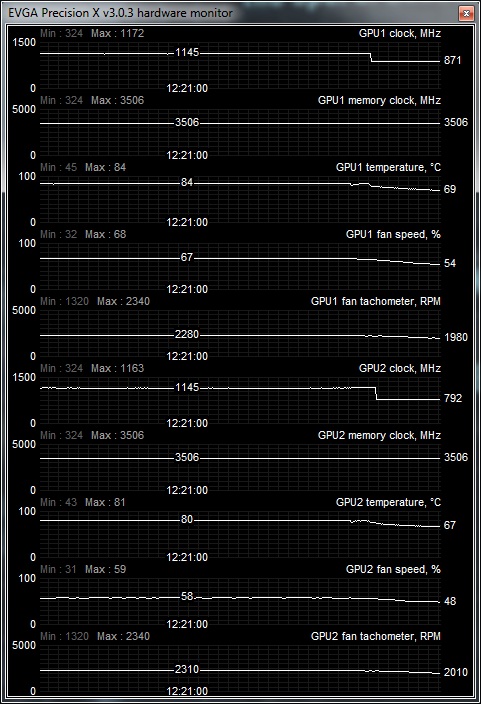
Once we maxed out the fans, we measured 77°C. Note that the maximum allowed RPM, which is 2900, made the fans quite loud, but not what we’d call unbearable.
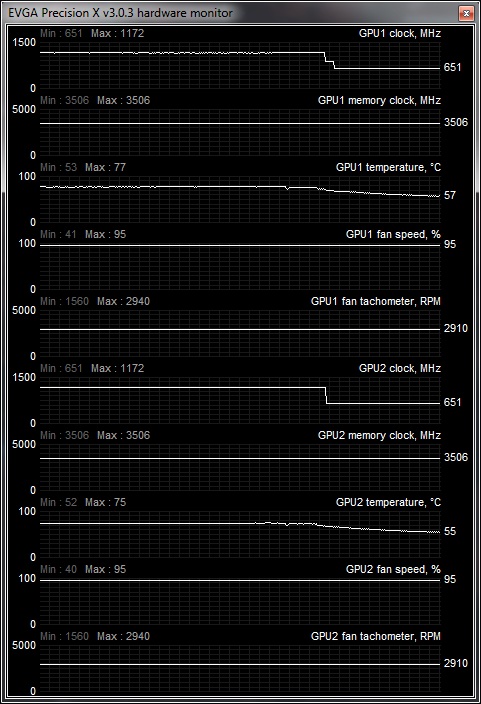
Power Consumption
Consumption is significantly lower and as much has 90W lower than what a GTX 680 SLI would draw.

Nvidia did a great job and Kepler has proven its dominance over Fermi generation, both in power consumption and thermals. These two advantages in particular are what made it possible to build a dual-GPU card that’s quieter than all the earlier dual-GPU cards, while being faster at the same time.
Gainward could have perhaps personalized the cooler, but we won’t pick hairs and besides – if it ain’t broken, it don’t need fixing. The reference cooling is, dare we say it, sexy and offers good performance at decent noise levels. In fact, considering that this is a dual GPU card, the thermals-to-noise ratio is quite nice. Additionally, the GTX 690 is quieter than two GTX 680 cards in SLI mode.
As far as performance goes, the GTX 690 is slightly behind two GTX 680 in SLI, mostly due to lower GPU clocks. In fact, the GTX 690’s GPUs run 9 percent slower that the ones on GTX 680 cards, which is practically the only difference between these GPUs.
Overclocking potential isn’t as good as the GTX 680’s, but we managed to squeeze out up to 16 percent better performance with very little effort. When it comes to consumption, the GTX 690 beats a GTX 680 SLI system by almost 90W.
The GTX 690’s performance is mouth watering and although some may say it’s an overkill for gaming, remember that 1920x1080 is a joke for what this card can do. If you want to play at 2560x1600 or are planning for some surround gaming, then you’ll want only the best. Two overclocked GTX 670 cards may be more affordable, and the same goes for two GTX 680s in SLI, but the GTX 690 offers a serious punch in a single package.
Gainward GTX 690 currently goes for about €900, which is a big plus as it cost €1000 only a few months ago. Not your average pocket money for sure, but not your average budget card either. Besides, we’re talking about the fastest graphics card on the market and that sort of performance never came cheap. In conclusion, if you’re looking for the leanest and meanest card on the market, Gainward GTX 690 has your name written all over it.



